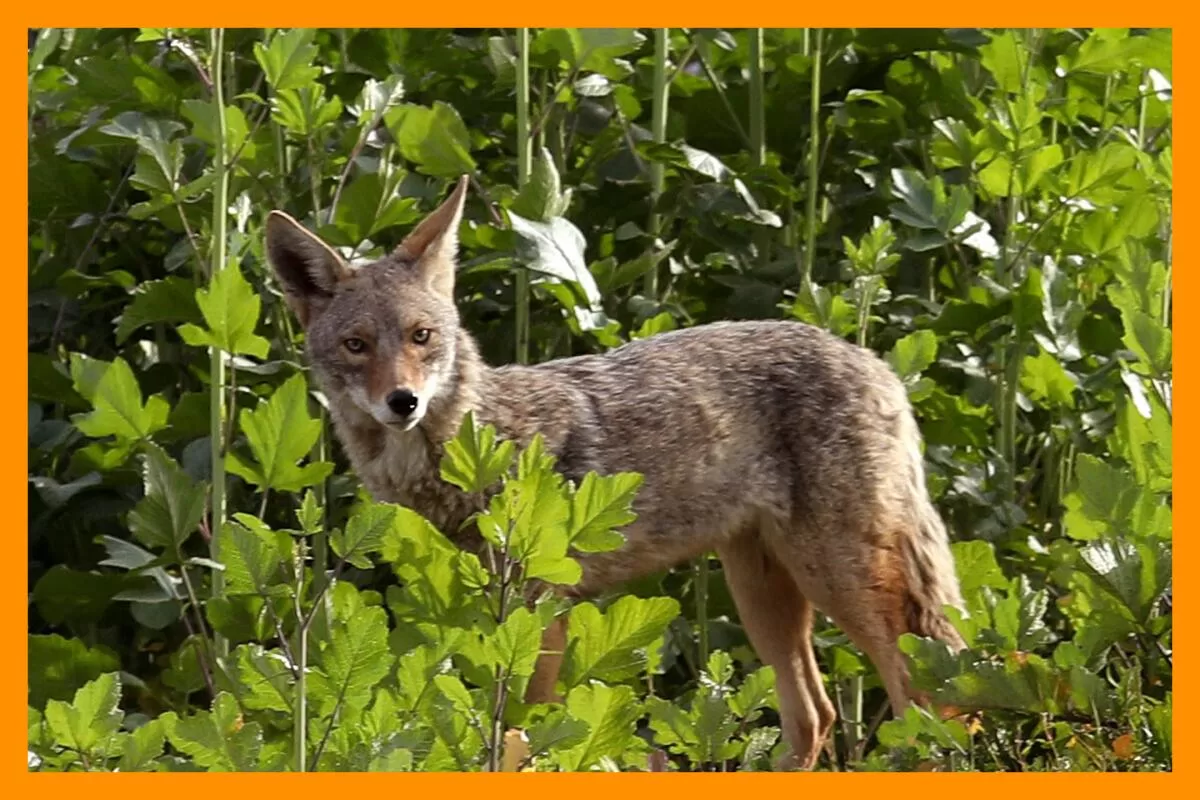My friend Ameera and I were almost back to the parking lot after hiking to Mt. Hollywood under a full moon when she spotted something about 30 feet ahead on the trail.
“Is that a coyote?” she asked.
Newsletter
You are reading The Wild newsletter
Sign up to get expert tips on the best of Southern California’s beaches, trails, parks, deserts, forests and mountains in your inbox every Thursday
You may occasionally receive promotional content from the Los Angeles Times.
I squinted and then complimented her vision. We’d been hiking for about five miles that evening and had yet to spot one of L.A.’s wild song dogs. I knew after recently writing about bears that our ursine neighbors often use hiking trails to traverse the woods and figured this coyote was doing the same. After spotting us, it stood still and looked us over.
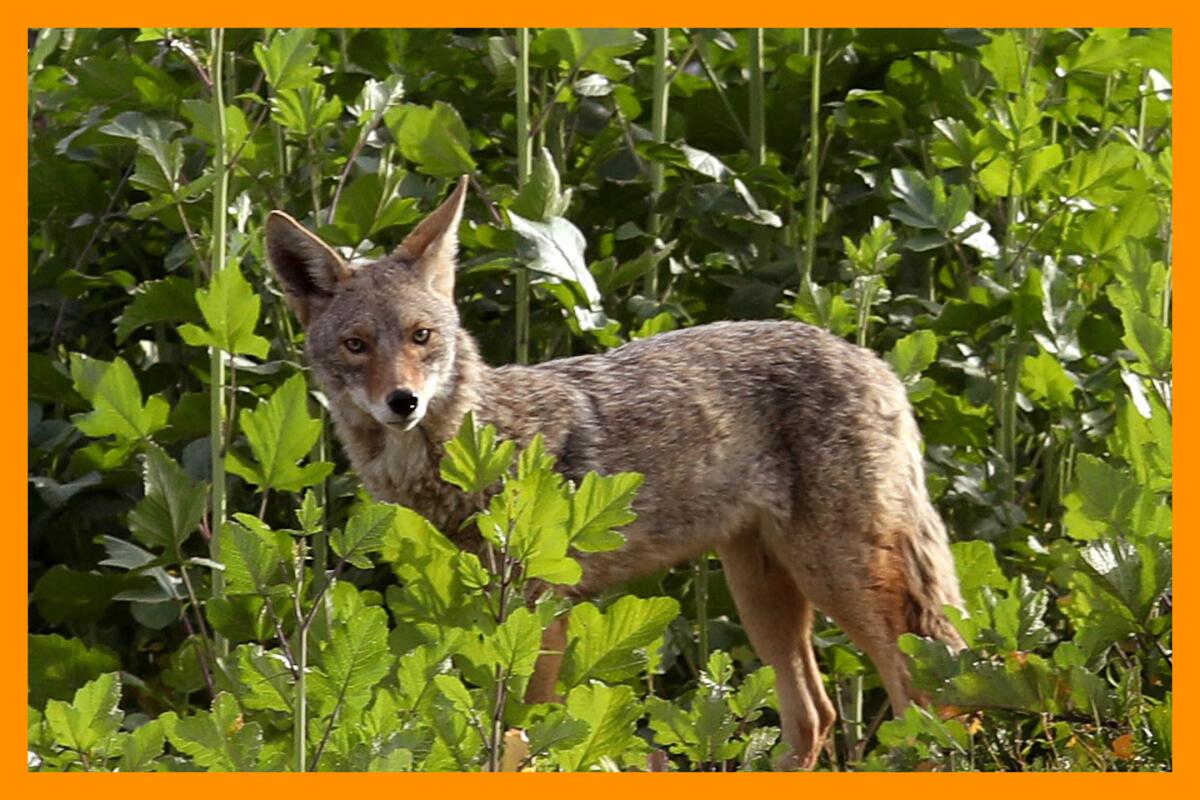
Coyotes can be spotted in nearly every part of Los Angeles County.
(Genaro Molina / Los Angeles Times)
I started to shout and clap to encourage the coyote to move along. It remained. I picked up a rock and threw it in the coyote’s direction, with the intent to scare — not hit — it. The coyote scurried ahead and we walked forward. Then, after pausing to check whether we were still there, it ran off trail into a nearby picnic area. Ameera and I walked past with my dog, Maggie, without further incident. I felt sorry to ruin its evening hunt.
I wanted to know afterward: Was I doing this whole coyote “hazing” thing correctly?
“What you did is exactly what is the right response,” Camilla Fox, founder and executive director of California-based Project Coyote, told me. “We do share our neighborhoods that include our green spaces and trails with other wild animals, and just like us, they’re looking for easy, safe passage.”
It seems impossible to be a hiker in L.A. and not see coyotes. It’s common enough to see them just in and around your neighborhood. As my (retired) colleague Louis Sahagún wrote in 2022, “coyotes have been tracked, spotted and photographed in virtually all developed areas of Los Angeles County, whether darting between headstones in a Boyle Heights cemetery, foraging through trash on a sandy South Bay boardwalk, or loping across a middle school athletic field in Paramount.”
So, to ensure both you and L.A.’s coyote population remain safe out there, I’ve put together some helpful tips for what to do if you encounter a so-called desert wolf.
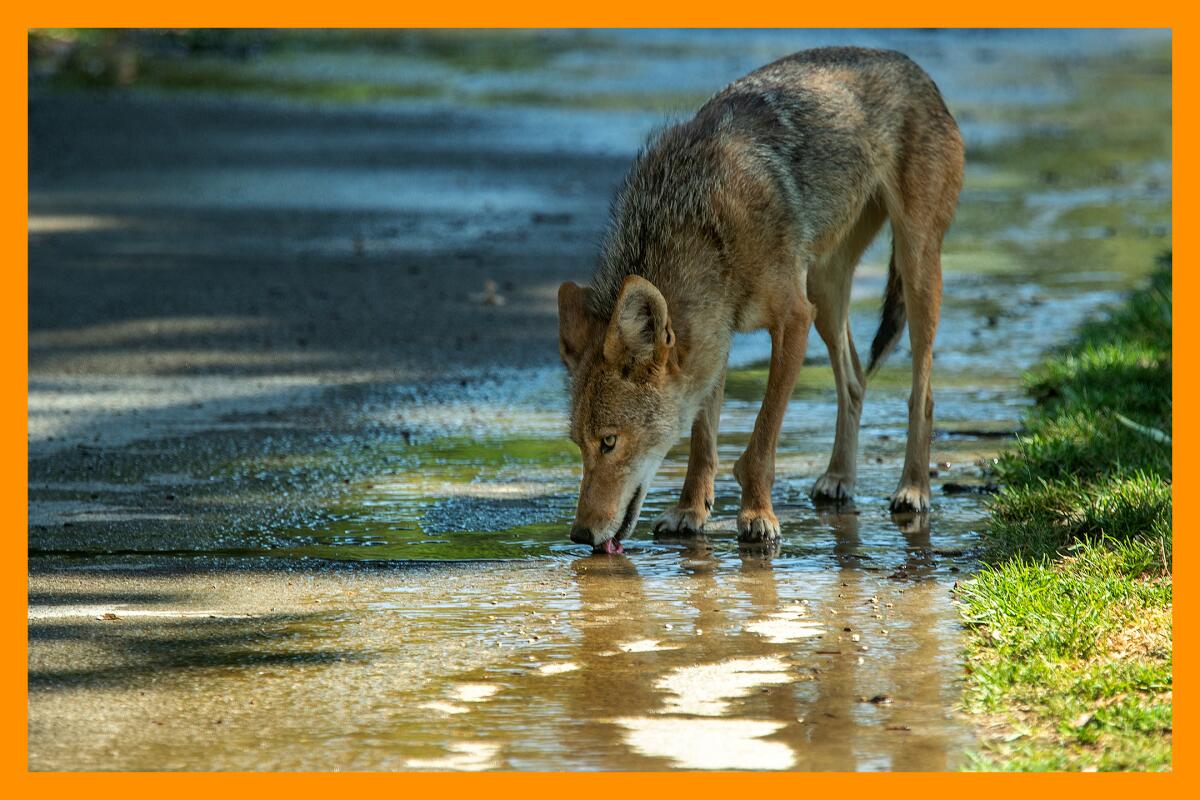
A coyote licks up water puddling up on the cart path next to the 16th green of the Harding golf course at Griffith Park..
(Mel Melcon / Los Angeles Times)
1. Take a moment to discern what the coyote is doing
Unless a coyote has been fed by humans — which has long been a problem in Griffith and other local parks — “coyotes want nothing to do with us,” Fox said. “Their inherent characteristic is they’re wild and wary of humans in general.”
But, much like dogs, they’re also curious. If a coyote spots you walking with your dog on the trail, it might stop to observe you both. Don’t assume it’s doing this because it plans to attack.
2. Consider moving elsewhere
If the coyote is walking toward you on a sidewalk, consider crossing the street so you can safely walk past it, and it can continue onward.
Outside of that, consider: Is this coyote wanting me to move so it can continue on the trail? Is it going the same direction as me?
As with any wild animal encounter, do not run. If hiking or walking with a small child or dog, pick them up. If the child is older, have them stand behind you. Make sure your dog is leashed and pulled tight near to you.

“Coyotes want nothing to do with us,” Camilla Fox, founder and executive director of California-based Project Coyote, said. “Their inherent characteristic is they’re wild and wary of humans in general.”
(Mel Melcon / Los Angeles Times)
3. Be big and loud, directing your attention at the coyote
If the coyote wasn’t spooked by simply seeing you, it’s time to consider hazing. Fox said there’s no definitive rules of when you should start hazing, the term used to describe behaviors meant to scare off a coyote.
“If the distance feels uncomfortable, then haze,” Fox said. “Be big and loud, and make noise, make yourself look as big as you can, and really direct your attention at that particular coyote. It is important that they know the big badness, the loudness, is oriented toward them, and that they respond to your behavior and leave the area.”
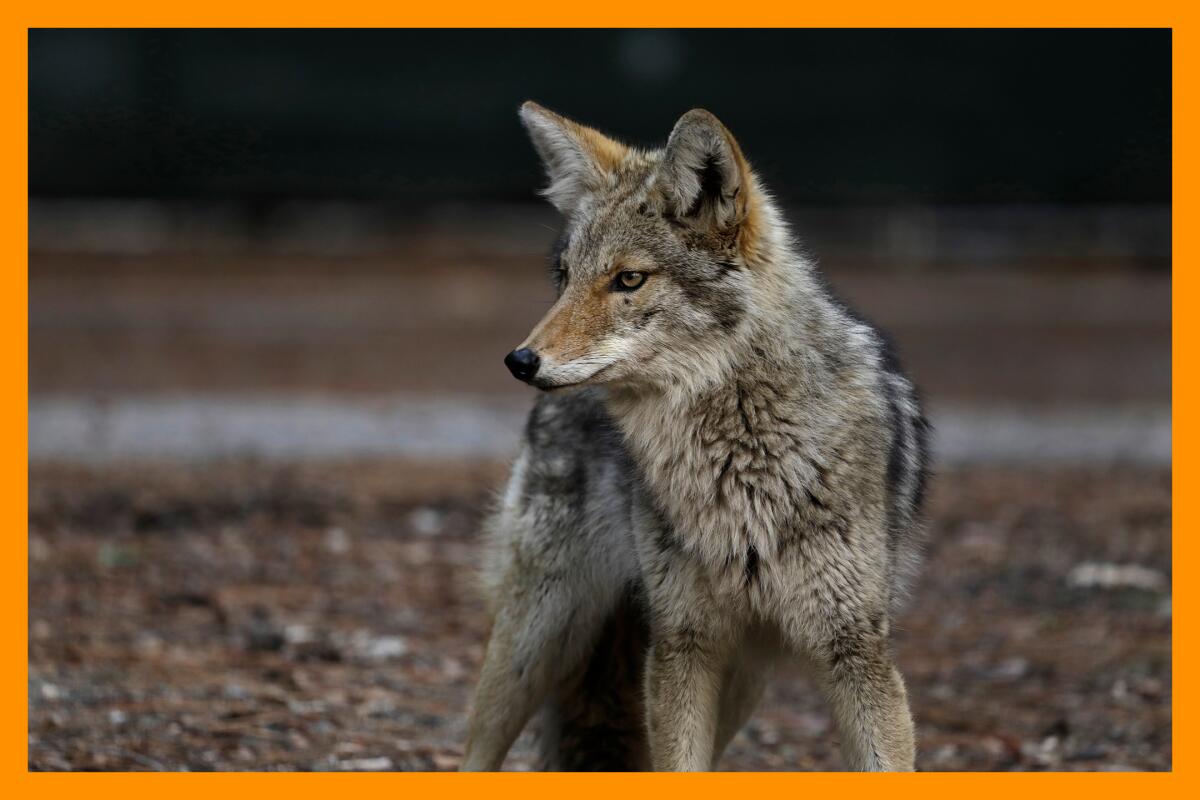
A coyote wanders around Curry Village in Yosemite Valley.
(Carolyn Cole / Los Angeles Times)
4. Increase hazing intensity
If the coyote is unmoved by yelling, throw rocks in its direction. If you have a whistle, use it.
At the same time, if you’re in a neighborhood, try to make sure you don’t scare the coyote into traffic.
In very rare instances, a coyote might walk toward you. If you happen to have an encounter like this in spring, it could be because it’s pup season, which runs generally March through May. During this time, it’s more common for coyotes to attempt to escort you away from its den by following you. When it decides you’re a safe enough distance from its pups, it’ll stop.
This happened to me, my wife and our dog Maggie once. We were at Silver Lake Reservoir — way too late in the evening — and spotted a coyote near the meadow off Silver Lake Boulevard. We hopped over the concrete ledge to walk on the street, and the coyote followed us. It was terrifying (and our fault). Finally, I turned on our stun gun, and the crackling sound it made scared it off.
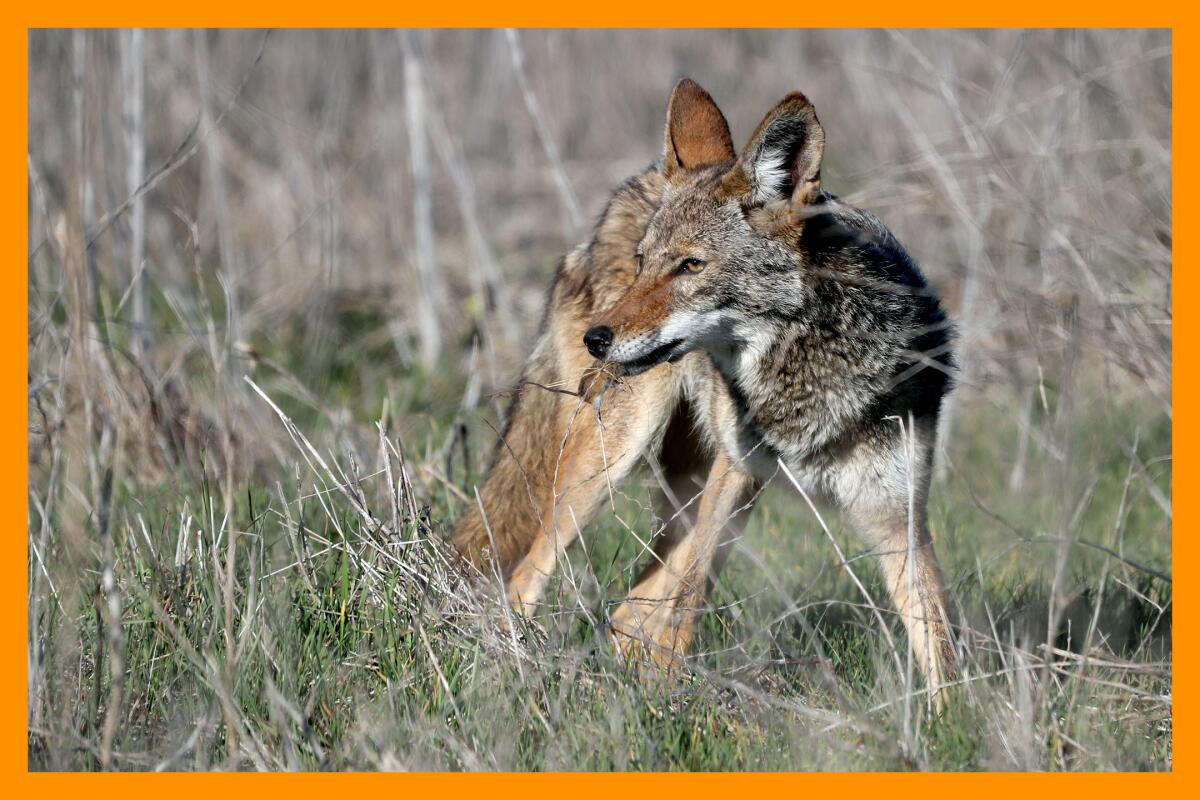
A coyote catches a small rodent at Fairview Park in Costa Mesa.
(Raul Roa / Los Angeles Times)
Like many of you, I have a complicated relationship with coyotes.
Growing up, I loved falling asleep to the sound a pack howling from a nearby pasture. But, later, when I was in my 20s, my beloved dog Barbara was killed by a pack in that same pasture. In L.A., I have both enjoyed seeing and hearing them in Griffith Park, and also once chased a coyote out of my apartment complex’s front yard when I realized it was trying to eat my neighbor’s cat, who hid in the bushes nearby. Who do we vilify here — my neighbor whose cat demands to go outside and is depressed when its stuck indoors, or the coyote for looking for an easy meal?
I vote neither. Instead, I’d like to encourage you to familiarize yourself with the tips above and of the important role coyotes play in our ecosystem.
Research shows, Fox said, that coyotes can eat up to 1,800 rodents per year. Coyotes also, through competitive exclusion, keep populations of raccoon, skunks, opossums and foxes naturally regulated. By keeping those animals in check, coyotes inadvertently benefit song and ground birds, whose eggs are often eaten by smaller carnivores.
“We share our urban landscapes with a variety of wild animals,” Fox said. “That includes mountain lions, coyotes, sometimes bears. They all have an important role, and the best thing we can do is to peacefully coexist.”

3 things to do
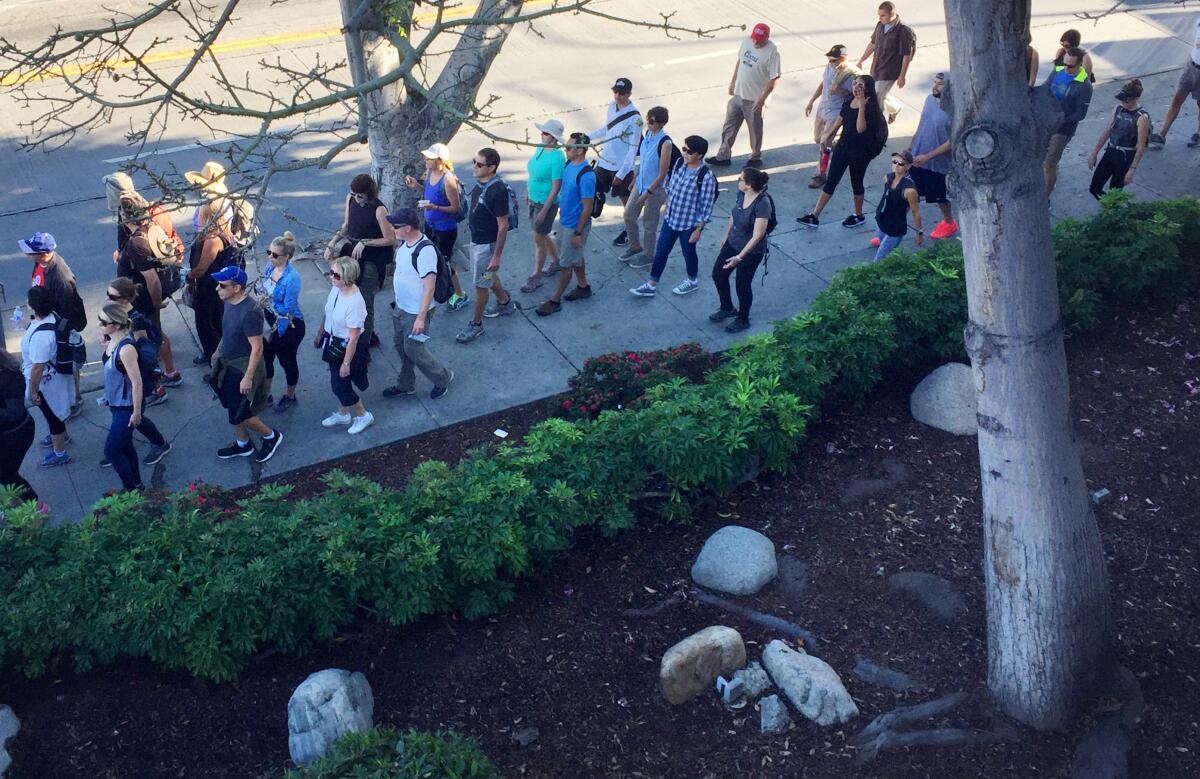
Participants walking on Beverly Boulevard during the Great Los Angeles Walk in 2017.
(Courtesy of Michael Schneider)
1. Walk with hundreds through L.A.
Join hundreds Saturday for the 19th Great Los Angeles Walk, a journey just under 14 miles from Exposition Park to UCLA. Just before 9 a.m., the group will meet at the city’s oldest palm tree on Exposition Park Drive, just off Figueroa Street, at the West 39th Street intersection. The path continues west through Mid-City and Culver City before ending just outside UCLA. There is an after-party on the patio of Broxton Brewery & Public House at 1099 Westwood Blvd. This is an unofficial event, meaning there’s no formal infrastructure to support walkers. Rather, it’s an informal group of walkers exploring the city, sightseeing, eating and having fun together. Walkers are welcome to join or drop off at any point. As a bonus, Times Wellness Editor Alyssa Bereznak will be at the beginning of the event, handing out issues of our recent L.A. walking guide. Learn more at greatlawalk.blogspot.com.
2. Tune into your senses in the Baldwin Hills
The Nature Nexus Institute will host a family-friendly hike from 3 to 5 p.m. Saturday in the Baldwin Hills park lands. Hike leaders will focus the group on the natural soundscape of the landscape. RSVP to [email protected] for details and to register. Learn more at the organization’s Instagram page.
3. Hike and learn history in Sierra Madre
The Sierra Madre Public Library will host a three-mile moderate hike from 7 to 10 a.m. Saturday up the Mount Wilson Trail to First Water. Along the way, Sierra Madre Trail maintenance crew coordinator Bob Spears will share stories and history of the trail. The hike gains about 1,000 feet of elevation in the first 1.5 miles and has little shade. Participants should bring water and sun protection, and wear closed-toe hiking shoes or boots. Parking is limited, so plan accordingly. Register at eventbrite.com.

The must-read
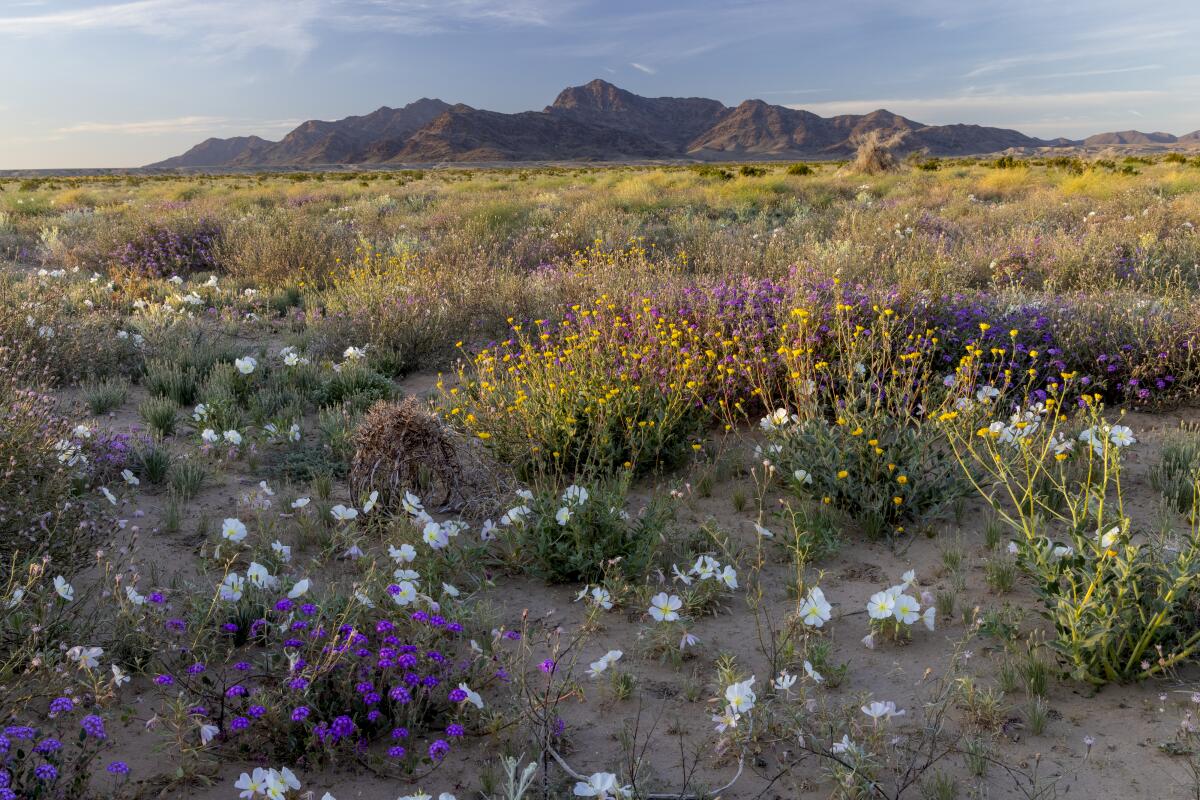
A view of wildflowers and the Mule Mountains, land that would be included in the proposed Chuckwalla National Monument.
(Bob Wick)
Tribal leaders and environmentalists want President Biden to preserve three new national monuments in California before President-elect Donald Trump takes office Jan. 20. Times staff writer Lila Seidman reports that their request includes a Chuckwalla national monument that would protect about 620,000 acres near the Salton Sea to the Colorado River. Rep. Raul Ruiz (D-Indio) told Seidman that he’s confident Biden will act on Chuckwalla, which has an established campaign and widespread approval. But could their work simply be undone by a new administration? In his first term, Trump shrunk the size of Bears Ears National Monument — which President Obama formally protected in 2016 — by 85% and slashed Grand Staircase-Escalante by about half, which President Clinton established in 1996. The Biden administration reversed the changes four years later in 2021.
Happy adventuring,

P.S.
Who needs an excellent excuse to get a tattoo? Black Penny Tattoo (1419 E. Santa Clara St., Ventura) will host a flash tattoo fundraiser from 10 a.m. to 6 p.m. Saturday to raise money for the Santa Monica Mountains Fund, an official National Parks Service partner that does essential work in our beloved mountains. The money will be used for the fund’s wildfire resiliency, resistance and restoration project. Tattoo options include native plants, birds and a little snake. I’m personally eyeing the mountain range. Your new ink will be a great conversation starter at any Thanksgiving table!
For more insider tips on Southern California’s beaches, trails and parks, check out past editions of The Wild. And to view this newsletter in your browser, click here.
